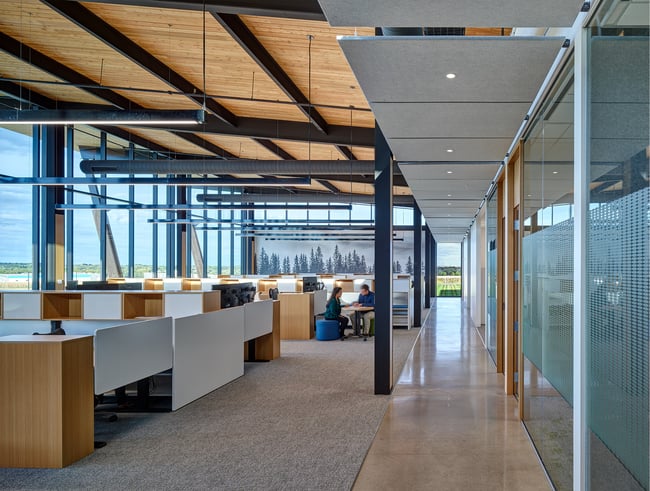Diversity, Equity, and Inclusion (DEI) refer to policies and practices that welcome people of different backgrounds and ensure they have the support they need to succeed. In recent years, especially since the pandemic, many organizations have placed a greater emphasis on DEI initiatives.
Although DEI is often associated with administrative policies, these initiatives extend to workplace design. Physical spaces have the power to shape institutional cultures, and intentional design decisions can go a long way in promoting inclusivity and equity.
This article will focus on four design strategies that promote equity:
- Variation in spaces
- Individualized furniture
- Improved daylight access
- Universal design
After reading, you’ll better understand how design can fit into your broader DEI initiatives.
What is Equity?
Understanding the definition of equity can help explain its relationship to workplace design. Often, “equity” gets confused with “equality.” Although the terms are similar, they refer to different sets of practices.
Equality means everyone receives the same resources and opportunities—regardless of their background or needs. Equity, on the other hand, recognizes that each person has different circumstances and allocates resources and opportunities to reach equal outcomes.
Despite good intentions, practices that promote equality fail to recognize that everyone has a different starting point. When everyone is given the same treatment, employee-specific needs may be overlooked.
In an equitable workplace, employees are provided what they need and are empowered to do their best, knowing they are fully welcomed.
Design Strategies for an Equitable Workplace
Equitable design starts with including users in the design process and learning about their needs. Design strategies should center around creating a positive user experience by anticipating situations and providing options and accommodations for whatever situation may arise.
Approaches will differ from project to project, but at a high level, everyone should be able to access the tools they need to succeed.
1. Variation in Spaces
Variation in spaces is key to promoting equity in the workplace. While an equal workplace puts everyone in the same environment, an equitable workplace allows users to work in a way that best suits their needs.
Different spaces in a workplace may include:
- Traditional workstations
- Open collaboration spaces
- Enclosed collaboration spaces
- Private focus rooms.
Spatial variation is also an effective way to support neurodiversity. Sensory issues are common with neurodivergent individuals, and traditional, open offices can present acoustical distractions. Variation gives occupants the ability to perform different activities without hindering anyone’s ability to work.
Along with different spaces, the workplace should also include wellness rooms. These spaces can serve nursing mothers, individuals with diabetes or other chronic conditions, or people who need a moment of respite.
2. Individualized Furniture
Furniture is an important consideration in workplace design. While equal workplaces provide everyone with the same workstation, an equitable workplace acknowledges that everyone has different comfort and ergonomic needs.
Options like adjustable height desks give users more control over their environment, and additional options like high-top and lounge seating allow occupants to change their environment based on the task.

Adjustable height desks and varied furniture options.
3. Improved Daylight Access
Regular access to daylight during the workday is known to promote healthy circadian rhythms and boost moods. Unfortunately, most workplaces do not give occupants equal access to light.
Traditionally, many workplaces reserved perimeter spaces with windows for private offices. Although many offices are moving away from this practice, it can be difficult to give everyone equal access to light depending on the building’s footprint.
Equity becomes an important concept in these situations. Although you cannot give everyone the same view, you can find ways to distribute light more evenly.
For example, at the Stanley Center for Peace and Security, some offices overlook a courtyard while others face a neighboring building. To create more equity between offices, those facing the neighboring building are a green wall and a skylight that delivers light from above. Although everyone has a different view, there are equal opportunities to experience the benefits of daylight and biophilia.
Varying light levels can also provide occupants more control and choice. For example, lower light levels in focus rooms can create a more calming atmosphere. Variation gives occupants the ability to choose which type of lighting fits their activity.

Desks near the perimeter provide more equal access to light.
4. Universal Design
Universal design is perhaps the epitome of equity. It promotes the idea that an environment should be accessed, understood, and used by everyone regardless of age, size, or (dis)ability.
Traditionally, a building may have steps at an entry and a ramp around the corner to assist users in a wheelchair. A universally designed building would have on-grade entrance.
The goal is to create a space that is accessible and inclusive from the beginning, rather than add accommodations as an afterthought. Such design practices can destigmatize disability, remove barriers, and welcome people of all abilities.
Learn More About Workplace Design
Every organization depends on the diversity, engagement, and well-being of its team. DEI initiatives can help organizations provide better support and improve talent attraction and retention rates for all employees.
For organizations prioritizing DEI, workplace design is a key consideration. Your workplace represents and informs your culture, and employees should feel supported in their environment.
The design strategies listed here are only a starting point. Every building project is different, and occupant needs should drive design decisions. Engaging users in the early stages of the design process leads to the most successful outcomes.
Learn how an architect will include your team by reading about visioning and planning workshops.
